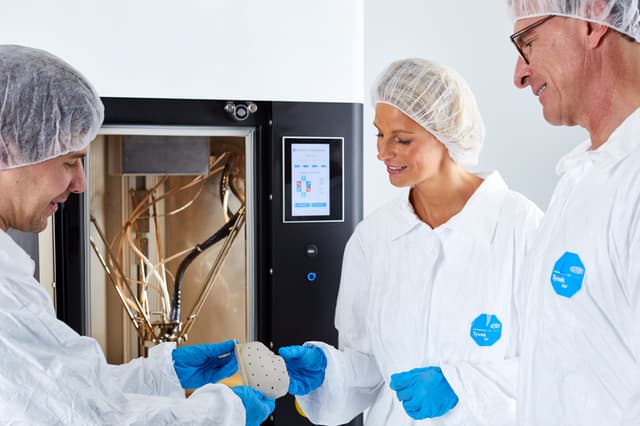Doctors at the University Hospital Basel have utilized 3D Systems‘ material extrusion 3D printing technology to create a patient-specific cranial implant. Traditionally, powder bed fusion and vat polymerization have been the go-to methods for crafting such implants, but material extrusion opens a new doorway, making 3D printing implants more accessible and user-friendly for hospital settings. This could potentially enable hospitals to 3D print medical devices on-site. Although it’s yet to be ascertained whether this practice will be reserved for urgent scenarios, novel medical devices, or unique surgical solutions, there’s a potential for it to become a more commonplace procedure.
Professor Florian Thieringer, head of the Medical Additive Manufacturing Research Group at the University Hospital Basel’s Department of Biomedical Engineering, collaborated with a team including Professor Raphael Guzman and Dr. Neha Sharma from the Department of Neurosurgery to fabricate patient-specific PEEK implants. The recipient was a 46-year-old male suffering from the effects of a stroke, manifested in headaches, dizziness, and skull deformities.
Utilizing a CT scan, a patient-specific implant was designed using Evonik’s VESTAKEEP i4 3DF PEEK. The team employed Oqton’s D2P and Geomagic Freeform to refine the scans and blueprint the implant. This echoes a prior case where Rainer Trummer, afflicted with craniosynostosis, was treated similarly. The implants were brought to life using 3D Systems’ EXT 220 MED material extrusion system, showcasing a practical application of 3D printing technology in addressing intricate medical conditions.
This event alone validates 3D Systems’ purchase of Kumovis. The German startup had carved a niche in developing a material extrusion medical system tailored for PEEK and other high-temperature materials before being acquired by 3D Systems. This success could catalyze a broader adoption of the EXT 220 MED across hospital settings. While the utility for cranial implants may not resonate with every institution, many hospitals have a need for high-quality, high-temperature 3D printing for items like braces, single-use surgical instruments, and other bespoke solutions. The trajectory of cranial implants becoming commonplace remains nebulous; it’s still a toss-up whether we’re witnessing a transient triumph or a harbinger of the 3D printing domain’s ‘NASCAR effect,’ where a victory on the race track on Sunday propels sales on Monday.
“The successful implantation at the University Hospital of Basel is a pivotal moment for medical 3D printing, demonstrating its potential to revolutionize patient care. Our collaboration with hospitals across Europe, along with the invaluable expertise provided by POC APP AG around QMS and regulatory guidelines, showcases the power of advanced technology and collaboration in improving healthcare outcomes,” Professor Thieringer said.
“We are proud to be at the forefront of this medical revolution, leveraging our expertise in 3D printing to bring tangible benefits to patients. Our collaboration with hospitals in Europe demonstrates the potential of 3D printing to transform healthcare, and we are excited to continue advancing this technology to address a broader range of medical needs. 3D Systems remains committed to driving innovation in the field of medical 3D printing, working hand in hand with healthcare professionals to enhance patient care and contribute to a brighter, healthier future,” said Stefan Leonhardt, Director of Medical Devices at 3D Systems.
For now, I truly believe that equipping a hospital with direct access to a 3D printer can empower surgical teams to tackle more challenging cases. The ability to craft a specific instrument or implant on-site could be the linchpin in healing someone afflicted with a perplexing condition. Edge cases and profoundly challenging scenarios could find resolution through unique surgical solutions. Concurrently, frameworks like the FDA’s extended access or compassionate use regulation provide a structured pathway for such investigative endeavors. In this scenario, the team adheres to medical device directives while crafting the implant right within the hospital premises.
I envision a second-order, high-volume usage for surgical instruments and other customized devices to address a multitude of patients with analogous issues. Although the notion of mass-producing implants within a hospital may pose a formidable challenge for many organizations, the potential to fundamentally reshape the value chain in medical devices is exhilarating. Moreover, the proximity to 3D printers could spark curiosity among more doctors, leading to the inception of breakthrough or perhaps just handy medical devices that could be life-saving. This setup not only fosters innovation but also significantly condenses the time and space between concept and application, which could be pivotal in critical medical situations.
Subscribe to Our Email Newsletter
Stay up-to-date on all the latest news from the 3D printing industry and receive information and offers from third party vendors.
Print Services
Upload your 3D Models and get them printed quickly and efficiently.
You May Also Like
The Market and Industry Potential of Multi-Material 3D and 4D Printing in Additive Electronics
Additive manufacturing leverages computer-based software to create components for products by depositing either dielectric or conductive materials, layer by layer, into different geometric shapes. Since its birth in the 1980s,...
3DPOD 262: Bio-inspired Design for AM with Dhruv Bhate, Arizona State University
Dhruv Bhate is an associate professor at Arizona State University. There, he looks at structures, materials, and design. Previously, he worked at PADT as well as in the semiconductor and...
3DPOD 261: Tooling and Cooling for AM with Jason Murphy, NXC MFG
Jason Murphy´s NXC MFG (Next Chapter Manufacturing) is not a generalist service; instead, the company specializes in making tooling. Using LPBF and binder jet, the company produces some of the...
3DPOD 260: John Hart on VulcanForms, MIT, Desktop Metal and More
John Hart is a Professor at MIT; he´s also the director of the Laboratory for Manufacturing and Productivity as well as the director of the Center for Advanced Production Technologies....

































